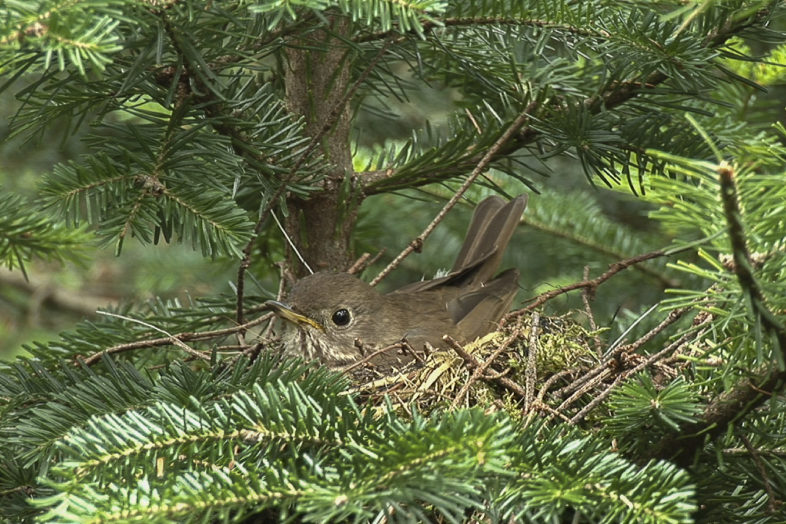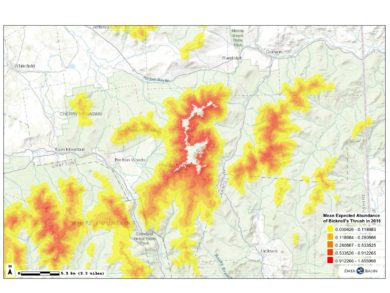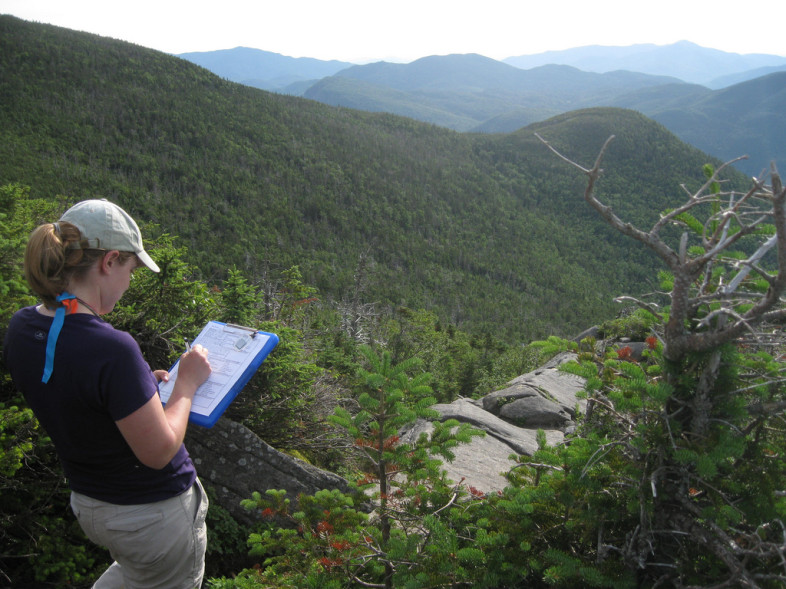
Bicknell’s Thrush (Catharus bicknelli) incubating a nest on Stratton, Vermont. Photo by K.P. McFarland
NORWICH, VT — New research by the Vermont Center for Ecostudies (VCE) has revealed that Bicknell’s Thrush likely have one of the smallest population sizes – about 71,000 adult birds – of any migratory songbird within the contiguous U.S. These findings were published in the research journal Ecosphere by lead authors Jason Hill and John Lloyd.
The enigmatic Bicknell’s Thrush, with its swirling flute-like song and speckled breast, is one of the most range-restricted songbirds in North America. It breeds in cool, moist evergreen forests on high mountains of the northeastern U.S. and coastal lowlands of southeastern Canada. Over the next several hundred years, climate change is expected to cut in half the extent of Bicknell’s Thrush breeding habitat in the Northeast. During the winter months, this species retreats to wet broadleaf forests in the Greater Antilles, where it faces ongoing habitat loss in its wintering range on the islands of Hispaniola, Cuba, Jamaica, and Puerto Rico. In light of its small geographic range and threats to its breeding and winter habitats, Bicknell’s Thrush is currently a candidate for listing under the U.S. Endangered Species Act. The species is already listed as Threatened under Canada’s Species at Risk Act.
“This research fills a critically-needed information void that has posed a substantial hindrance to assessing the conservation status of Bicknell’s Thrush,” says lead author Jason Hill. “This type of research just wouldn’t be possible without the monstrous efforts of our dedicated citizen scientists. To facilitate conservation and management actions, we have made the results of our study available in such a way that anyone can download our data and easily produce an estimate for the number of Bicknell’s Thrush that breed on any property in the Northeast.”

Abundance estimate map for the Mount Washington, New Hampshire area created at databasin.org. The new map can be downloaded or viewed online at Data Basin: a free and open portal to thousands of scientifically-grounded spatial datasets (visit https://databasin.org/galleries/b5e98de6a2fb43d586665256ec78059f).
The VCE study also indicates that 85% of the U.S. Bicknell’s Thrush population occurs on conserved lands, including state and national forests and private lands with conservation easements. In fact, more than half of the U.S. Bicknell’s Thrush population likely occurs on just three blocks of public land: White Mountain National Forest in New Hampshire and Maine, Baxter State Park in Maine, and the High Peaks Wilderness Area of the Adirondack Park in New York. White Mountain National Forest in New Hampshire, alone, likely harbors nearly one-third – about 22,000 adult birds – of the U.S. Bicknell’s Thrush population and perhaps 18% of the global (U.S. and Canada) population.
The new abundance map can be downloaded or viewed online at Data Basin: a free and open portal to thousands of scientifically-grounded spatial datasets.
The data used in the study were garnered over the last six years by trained citizen scientists, who are experienced birders, under the Mountain Birdwatch (MBW) monitoring program overseen by VCE. Rising well before sunrise in June to catch the first bird notes of the dawn chorus, these observers annually conduct surveys for Bicknell’s Thrush and nine other montane bird species at nearly 750 designated locations along hiking trails located in high-elevation forests throughout the Northeast. This monitoring, the only means by which Bicknell’s Thrush populations are tracked, has been largely funded by the U.S. Fish and Wildlife Service.
“I was compelled to participate by my concerns for what I was seeing on Catskill Mountain summits related to the effects of acid rain and climate change, and the very limited and vulnerable nature of Bicknell’s Thrush breeding habitat in the relatively southern latitudes that are the Catskill Mountains,” said Steve Chorvas, a veteran citizen scientist with MBW who has conducted surveys each year since 2001.
The International Bicknell’s Thrush Conservation Group (IBTCG) recently completed an updated plan to protect Bicknell’s Thrush across its entire range, from the Caribbean to Canada, that addresses the primary threats facing Bicknell’s Thrush and the actions that may help mitigate them. The IBTCG is an alliance of scientists, natural-resource managers, and government officials committed to advancing the study and conservation of Bicknell’s Thrush through sound science and international cooperation.
Bicknell’s Thrush feeding nestlings on Stratton Mountain, Vermont.


Great work VCE, IBTCG and all the citizen scientists.
There is a nice story on WAMC Northeast Public Radio about this work too. Have a listen at http://wamc.org/post/study-maps-and-estimates-population-rare-songbird